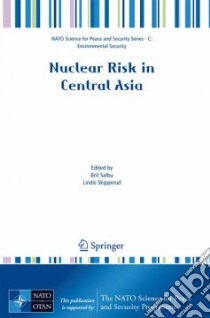- Libreria
- >
- Libri in lingua
- >
- Politica
- >
- Altri argomenti riguardanti guerra e difesa
Nuclear Risk in Central Asia - 9781402083167
Un libro in lingua di Salbu Brit (EDT) Skipperud Lindis (EDT) edito da Springer Verlag, 2008
- € 101.90
- Il prezzo è variabile in funzione del cambio della valuta d’origine
There are a significant number of nuclear and radiological sources in Central Asia, which have contributed, are still contributing, or have the potential to contribute to radioactive contamination in the future. Key sources and contaminated sites of concern are: (1) The nuclear weapons tests performed at the Semipalatinsk Test Site (STS) in Kazakhstan during 1949-1989; (2) Safety trials at STS, where radioactive sources were spread by conventional explosives; (3) Peaceful nuclear explosions (PNEs) within STS and outside STS in Kazakhstan, producing crater lakes and waste storage facilities etc.; (4) Technologically enhanced levels of naturally occurring radionuclides (TENORM) due to U mining and tailing. As a legacy of the cold war and the nuclear weapon programme in the former USSR, thousands of km2 in the Central Asia countries are contaminated; (5) Large amounts of scale from the oil and gas industries contain sufficient amounts of TENORM; (6) Nuclear reactors, to be decommissioned or still in operation; (7) Storage of spent nuclear fuel and other radioactive wastes.The NATO Environmental Security Panel has recognized key hazards of concern: Natural Hazards, Human Induced Environmental Hazards, and the Degradation of the World's Natural Resource Base. Thus, nuclear and radiological risks are well within the scope of NATO ESP. Nuclear and radiological risks and potential transboundary contamination represent an international challenge, and are highly relevant for Central Asia. Therefore, the NATO Advanced Research Workshop (ARW): “Nuclear Risks in Central Asia” was organized as a top-down initiative, and the papers from this ARW are compiled in this book.
Informazioni bibliografiche
- Titolo del Libro in lingua: Nuclear Risk in Central Asia
- Lingua: English
- Autori : Salbu Brit (EDT) Skipperud Lindis (EDT)
- Editore: Springer Verlag
- Collana: Springer Verlag (Paperback)
- Data di Pubblicazione: 07 Aprile '08
- Genere: SCIENCE
- Argomenti : Radioactive pollution Asia, Central
- Pagine: 237
- Dimensioni mm: 234 x 152 x 19
- ISBN-10: 1402083165
- EAN-13: 9781402083167


